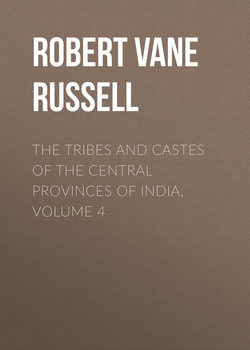Читать книгу The Tribes and Castes of the Central Provinces of India, Volume 4 - Robert Vane Russell - Страница 92
Part II
Articles on Castes and Tribes
Kumhār—Yemkala
Vol. IV
Lakhera
6. Vermilion and spangles
ОглавлениеAmong the constituents of the Sohāg or lucky trousseau without which no Hindu girl of good caste can be married are sendur or vermilion, kunku or red powder or a spangle (tikli), and mahāwar or red balls of cotton-wool. In Chhattīsgarh and Bengal the principal marriage rite is usually the smearing of vermilion by the bridegroom on the parting of the bride’s hair, and elsewhere this is commonly done as a subsidiary ceremony. Here also there is little reason to doubt that vermilion is a substitute for blood; indeed, in some castes in Bengal, as noted by Sir H. Risley, the blood of the parties is actually mixed.88 This marking of the bride with blood is a result of the sacrifice and communal feast of kinsmen already described; only those who could join in the sacrificial meal and eat the flesh of the sacred animal god were kin to it and to each other; but in quite early times the custom prevailed of taking wives from outside the clan; and consequently, to admit the wife into her husband’s kin, it was necessary that she also should drink or be marked with the blood of the god. The mixing of blood at marriage appears to be a relic of this, and the marking of the forehead with vermilion is a substitute for the anointing with blood. Kunku is a pink powder made of turmeric, lime-juice and borax, which last is called by the Hindus ‘the milk of Anjini,’ the mother of Hanumān. It seems to be a more agreeable substitute for vermilion, whose constant use has probably an injurious effect on the skin and hair. Kunku is used in the Marātha country in the same way as vermilion, and a married woman will smear a little patch on her forehead every day and never allow her husband to see her without it. She omits it only during the monthly period of impurity. The tikli or spangle is worn in the Hindustāni Districts and not in the south. It consists of a small piece of lac over which is smeared vermilion, while above it a piece of mica or thin glass is fixed for ornament. Other adornments may be added, and women from Rājputāna, such as the Mārwāri Banias and Banjāras, wear large spangles set in gold with a border of jewels if they can afford it. The spangle is made and sold by Lakheras and Patwas; it is part of the Sohāg at marriages and is affixed to the girl’s forehead on her wedding and thereafter always worn; as a rule, if a woman has a spangle it is said that she does not smear vermilion on her forehead, though both may occasionally be seen. The name tikli is simply a corruption of tīka, which means a mark of anointing or initiation on the forehead; as has been seen, the basis of the tikli is vermilion smeared on lac-clay, and it is made by Lakheras; and there is thus good reason to suppose that the spangle is also a more ornamental substitute for the smear of vermilion, the ancient blood-mark by which a married woman was admitted into her husband’s clan. At her marriage a bride must always receive the glass bangles and the vermilion, kunku, or spangle from her husband, the other ornaments of the Sohāg being usually given to her by her parents. Unmarried girls now also sometimes wear small ornamental spangles, and put kunku on their foreheads. But before marriage it is optional and afterwards compulsory. A widow may not wear vermilion, kunku, or spangles.
88
See articles on Khairwār and Kewat.
